2006 SUBARU BAJA checking oil
[x] Cancel search: checking oilPage 138 of 487

3-11
Instruments and controls
– CONTINUED –
Warning and indicator lightsWarning and indicator lights
Several of the warning and indicator lights come on
momentarily and then go out when the ignition switch
is initially turned to the “ON” position. This permits
checking the operation of the bulbs.
Apply the parking brake and turn the ignition switch to
the “ON” position. The following lights come on:
Seatbelt warning light
SRS airbag system warning light
CHECK ENGINE warning light / Malfunction indica- tor lamp
Charge warning light
Oil pressure warning light
AT OIL temperature warn ing light (AT vehicles)
ABS warning light
Brake system warning light
All-Wheel Drive warning light (AT vehicles)
If any lights fail to come on, it indicates a burned-out
bulb or a malfunction of the corresponding system.
Consult your authorized SUBARU dealer for repair. �„ Seatbelt warning light and chime
�„Chime
�„ Seatbelt
�„ Warning lights
�„ SeatbeltWhen the ignition switch is turned to the “ON” position,
the seatbelt warning light will come on and the remind- er chime will sound for approximately six seconds to
remind the driver to fasten the seatbelt.
The seatbelt warning light remains on for approxmi-
ately six seconds and turns of
f automatically after six
seconds.
The seatbelt reminder chime will turn off when the
driver’s side seatbelt is bu ckled or it will turn off auto-
matically after six seconds. �„ SRS airbag system warning
light
�„SRS airbag system warning light
�„ Warning lights
�„ SRS airbag system
If the warning light exhi bits any of the following
conditions, there may be a malfunction in the
seatbelt pretensioners and/or SRS airbag sys-
tem. Immediately take your vehicle to your
nearest SUBARU dealer to have the system
checked. Unless checked and properly re-
paired, the seatbelt pretensioners and/or SRS
airbag will not operate properly in the event of
a collision, which may increase the risk of inju- ry.�y Flashing or flickering of the warning light.
�y No illumination of the warning light when the
ignition switch is first turned to the “ON” posi-
Page 175 of 487

4-12
Climate control
open for a few minutes to allow outside air to circulate
into the heated interior. This results in quicker cooling
by the air conditioner. Keep the windows closed during
the operation of the air conditioner for maximum cool- ing efficiency. �T
Lubrication oil circulation in the refrigerant cir-
cuit
Operate the air conditioner compressor at a low en-
gine speed (at idle or low driving speeds) a few min-
utes each month during the off-season to circulate its
oil. �T Checking air conditioning system before sum-
mer season
Check the air conditioner unit for refrigerant leaks,
hose conditions, and pro per operation each spring.
This check is best performed by your SUBARU dealer. �T Cooling and dehumidifying in high humidity
and low temperature weather condition
Under certain weather conditions (high relative humid-
ity, low temperatures, etc. ) a small amount of water
vapor emission from the ai r outlets may be noticed.
This condition is normal and does not indicate any
problem with the air conditioning system. �T
Air conditioner compressor shut-off when en-
gine is heavily loaded
To improve acceleration and gas mileage, the air con-
ditioner compressor is designed to temporarily shut off
during air conditioner operation whenever the acceler-
ator is fully depressed such as during rapid accelera-
tion or when driving on a steep upgrade. �T Refrigerant for your climate control system
Your air conditioner uses ozone friendly refrigerant
HFC134a. Therefore, the me thod of adding, changing
or checking the refrigerant is different from the method
for CFC12 (freon). Consult your SUBARU dealer for
service. Repairs needed as a result of using the wrong
refrigerant are not covered under warranty.
Page 366 of 487

11 - 1
11
Maintenance and service
Maintenance schedule ................................. 11-3
Maintenance precautions ............................ 11-3 Before checking or servicing in the engine compartment .................................................. 11-4
When you do checking or servicing in the engine compartment while the engine is
running ............................................................ 11-5
Engine hood .................................................. 11-5
Engine compartment overview ................... 11-8 Non-turbo models ............................................. 11-8
Turbo models .................................................... 11-9
Engine oil ...................................................... 11-10 Checking the oil level ....................................... 11-10
Changing the oil and oil filter .......................... 11-12
Recommended grade and viscosity ................ 11-15
Recommended grade and viscosity under severe driving conditions .............................. 11-16
Cooling system .... ....................................... .. 11-17
Hose and connections ...................................... 11-18
Engine coolant .................................................. 11-18
Air cleaner element ...................................... 11-23 Replacing the air cleaner element ................... 11-23
Spark plugs ................................................... 11-25 Recommended spark plugs ............................. 11-26
Drive belts ..................................................... 11-26
Manual transmission oil ............................... 11-27 Checking the oil level ....................................... 11-27
Recommended grade and viscosity ................ 11-29
Automatic transmission fluid ...................... 11-29 Checking the fluid level .................................... 11-29
Recommended fluid ......................................... 11-31
Front differential gear oil (AT vehicles) ...... 11-32
Checking the oil level ....................................... 11-32
Recommended grade and viscosity ............... 11-33
Rear differential gear oil . .............................. 11-33
Checking the gear oil level .............................. 11-33
Recommended grade and viscosity ............... 11-35
Power steering fluid ...................................... 11-36 Checking the fluid level .................................... 11-36
Recommended fluid ......................................... 11-38
Brake fluid ..................................................... 11-38 Checking the fluid level .................................... 11-38
Recommended brake fluid ............................... 11-39
Clutch fluid (MT vehicles) ............................ 11-40 Checking the fluid level .................................... 11-40
Recommended clutch fluid .............................. 11-41
Brake booster ................................................ 11-42
Brake pedal .................................................... 11-42 Checking the brake pedal free play ................ 11-42
Checking the brake pedal reserve distance ... 11-43
Clutch pedal (Manual transmission vehicles) ..................................................... 11-43Checking the clutch function .......................... 11-43
Checking the clutch pedal free play ............... 11-44
Replacement of brake pad and lining ......... 11-44 Breaking-in of new brake pads and linings .... 11-45
Parking brake stroke ......... ........................... 11-46
Tires and wheels ............. .............................. 11-46
Page 369 of 487
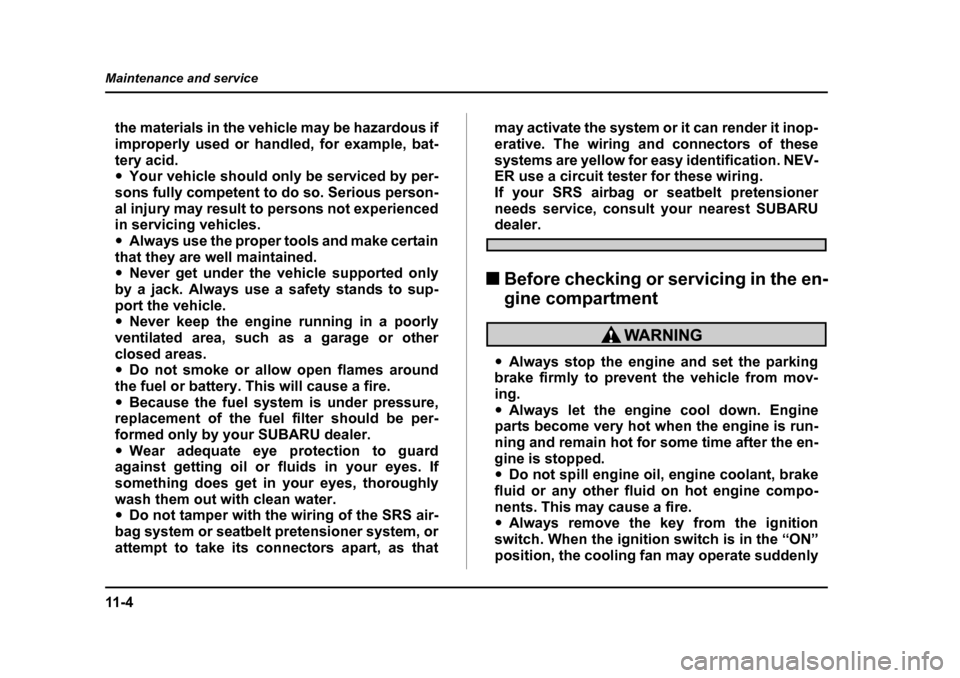
11 - 4
Maintenance and service
the materials in the vehicle may be hazardous if
improperly used or handled, for example, bat-tery acid. �y
Your vehicle should only be serviced by per-
sons fully competent to do so. Serious person-
al injury may result to persons not experienced
in servicing vehicles. �y Always use the proper tools and make certain
that they are well maintained. �y Never get under the vehicle supported only
by a jack. Always use a safety stands to sup-
port the vehicle. �y Never keep the engine running in a poorly
ventilated area, such as a garage or other
closed areas. �y Do not smoke or allow open flames around
the fuel or battery. This will cause a fire. �y Because the fuel system is under pressure,
replacement of the fuel filter should be per-
formed only by your SUBARU dealer.�y Wear adequate eye protection to guard
against getting oil or fl uids in your eyes. If
something does get in your eyes, thoroughly
wash them out with clean water. �y Do not tamper with the wiring of the SRS air-
bag system or seatbelt pretensioner system, or
attempt to take its connectors apart, as that may activate the system or it can render it inop-
erative. The wiring an
d connectors of these
systems are yellow for easy identification. NEV-
ER use a circuit tester for these wiring.
If your SRS airbag or seatbelt pretensioner
needs service, consult your nearest SUBARU
dealer.
�„ Before checking or servicing in the en-
gine compartment
�yAlways stop the engine and set the parking
brake firmly to prevent the vehicle from mov-
ing. �y Always let the engine cool down. Engine
parts become very hot when the engine is run-
ning and remain hot for some time after the en-
gine is stopped. �y Do not spill engine oil, engine coolant, brake
fluid or any other fluid on hot engine compo-
nents. This may cause a fire.�y Always remove the key from the ignition
switch. When the ignition switch is in the “ON”
position, the cooling fan may operate suddenly
Page 375 of 487
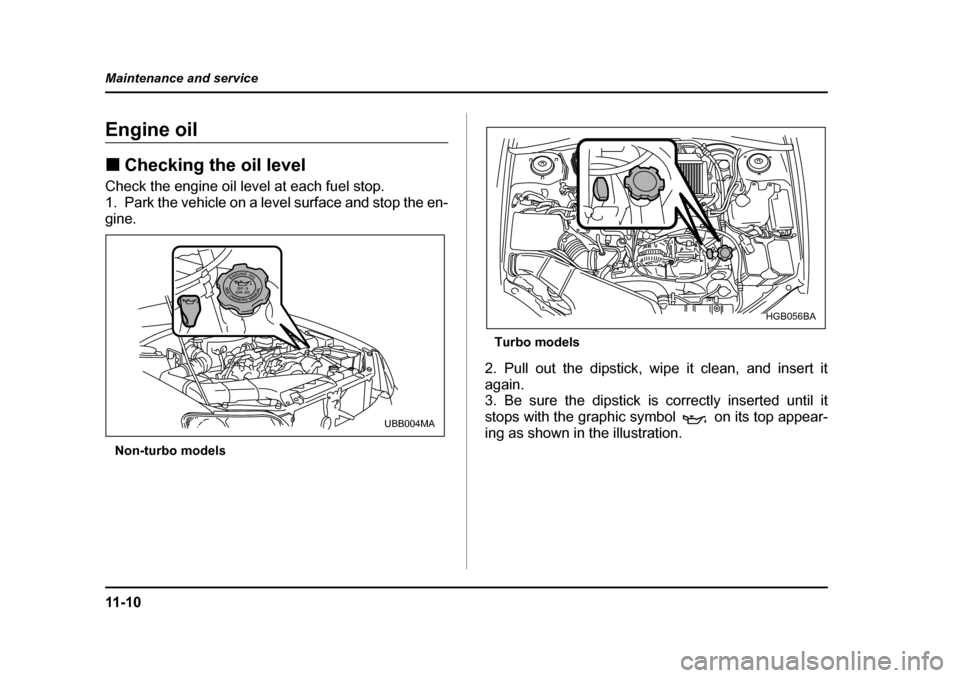
11 - 1 0
Maintenance and service
Engine oilEngine
Oil
Oil level
Engine
�„ Checking the oil level�„Checking
�„ Engine oil levelCheck the engine oil level at each fuel stop.
1. Park the vehicle on a level surface and stop the en-
gine.
Non-turbo models Turbo models
2. Pull out the dipstick, wipe it clean, and insert it
again.
3. Be sure the dipstick is correctly inserted until it
stops with the graphic symbol on its top appear-
ing as shown in the illustration.
UBB004MA
HGB056BA
Page 377 of 487
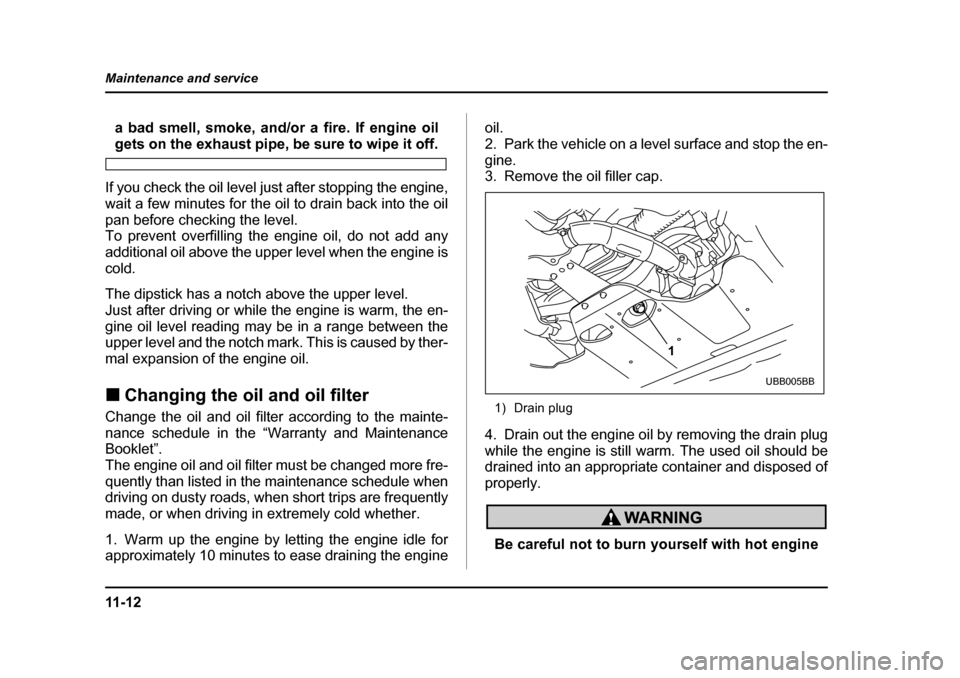
11 - 1 2
Maintenance and service
a bad smell, smoke, and/or a fire. If engine oil
gets on the exhaust pipe, be sure to wipe it off.
If you check the oil level just after stopping the engine,
wait a few minutes for the oil to drain back into the oil
pan before checking the level.
To prevent overfilling the engine oil, do not add any
additional oil above the upper level when the engine is cold.
The dipstick has a notch above the upper level.
Just after driving or while the engine is warm, the en-
gine oil level reading may be in a range between the
upper level and the notch mark. This is caused by ther-
mal expansion of the engine oil. �„ Changing the oil and oil filter
�„
Changing
�„ Oil and oil filterChange the oil and oil filter according to the mainte-
nance schedule in the “Warranty and Maintenance
Booklet”.
The engine oil and oil filter must be changed more fre-
quently than listed in the maintenance schedule when
driving on dusty roads, when short trips are frequently
made, or when driving in extremely cold whether.
1. Warm up the engine by letting the engine idle for
approximately 10 minutes to ease draining the engine oil.
2. Park the vehicle on a level surface and stop the en-
gine.
3. Remove the oil filler cap.
1) Drain plug
4. Drain out the engine oil by removing the drain plug
while the engine is still warm. The used oil should be
drained into an appropriate container and disposed of
properly.
Be careful not to burn yourself with hot engine
1
UBB005BB
Page 392 of 487
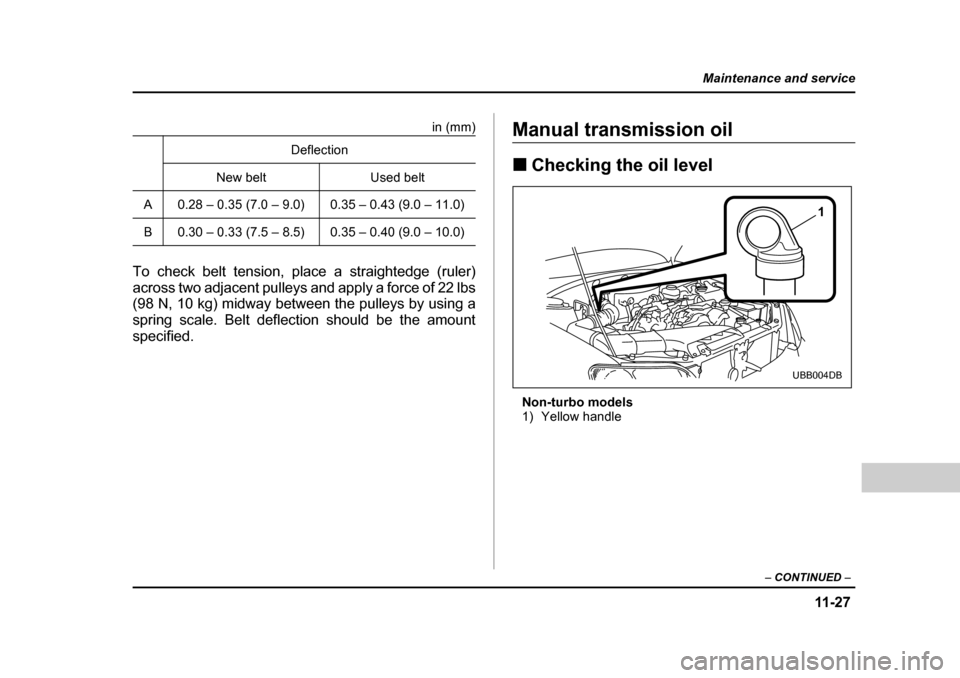
11 -2 7
Maintenance and service
– CONTINUED –
in (mm)
To check belt tension, place a straightedge (ruler)
across two adjacent pulleys and apply a force of 22 lbs
(98 N, 10 kg) midway between the pulleys by using a
spring scale. Belt deflection should be the amount
specified.Manual transmission oilManual transmission oil
Oil level
Manual transmission
�„ Checking the oil level0
Non-turbo models
1) Yellow handle
Deflection
New belt Used belt
A 0.28 – 0.35 (7.0 – 9.0) 0.35 – 0.43 (9.0 – 11.0)
B 0.30 – 0.33 (7.5 – 8.5) 0.35 – 0.40 (9.0 – 10.0)
1
UBB004DB
Page 394 of 487
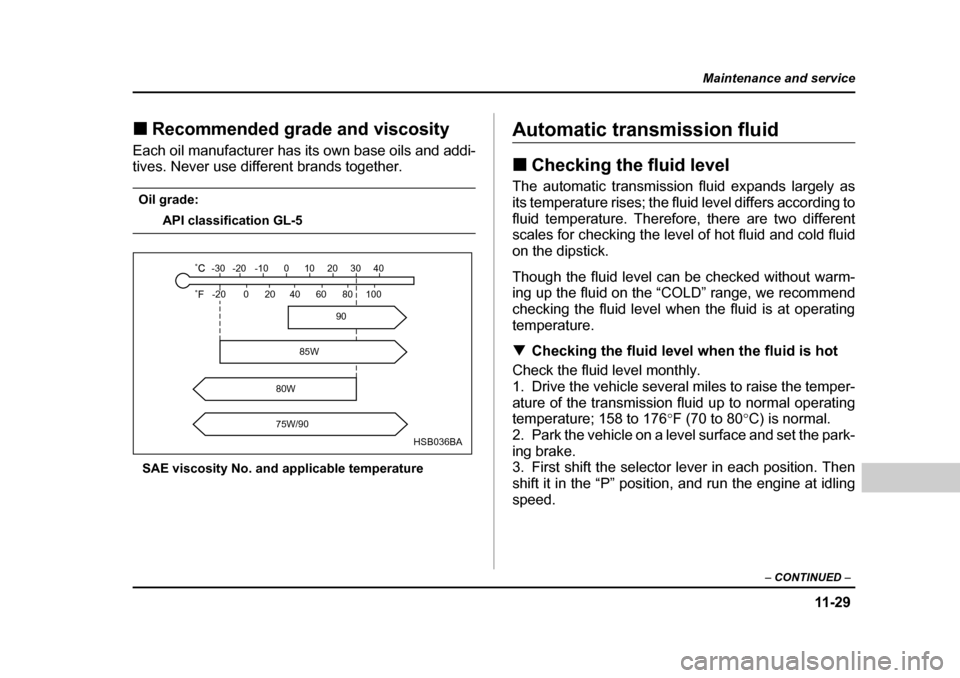
11 -2 9
Maintenance and service
– CONTINUED –
�„Recommended grade and viscosity�„
Recommended
�„ Oil grade and viscosityEach oil manufacturer has its own base oils and addi-
tives. Never use differ ent brands together.
Oil grade:
API classification GL-5
SAE viscosity No. and applicable temperature
Automatic transmission fluidAutomatic transmission
Fluid
Fluid level
Automatic transmission
�„ Checking the fluid level�„Checking
�„ Fluid levelThe automatic transmission fluid expands largely as
its temperature rises; the fluid level differs according to
fluid temperature. Therefore, there are two different
scales for checking the level of hot fluid and cold fluid
on the dipstick.
Though the fluid level can be checked without warm-
ing up the fluid on the “COLD” range, we recommend
checking the fluid level when the fluid is at operating
temperature. �T Checking the fluid level when the fluid is hot
Check the fluid level monthly.
1. Drive the vehicle several miles to raise the temper-
ature of the transmission fluid up to normal operating
temperature; 158 to 176 °F (70 to 80 °C) is normal.
2. Park the vehicle on a level surface and set the park-
ing brake.
3. First shift the selector lever in each position. Then
shift it in the “P” position, and run the engine at idling
speed.
-30 -20 -10 0 10 20 30 40
-20 0 60 20
80W
75W/90 80 100
40
85W 90
HSB036BA